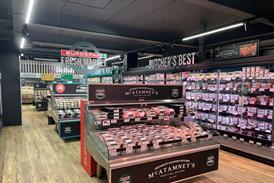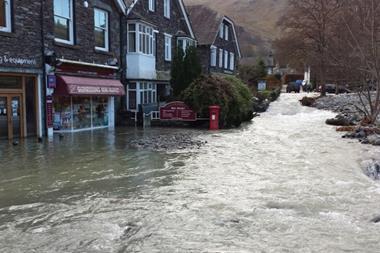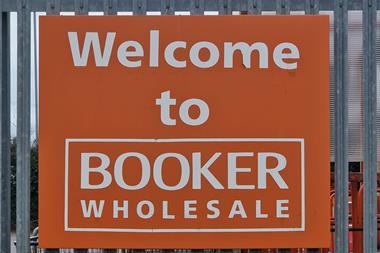As the UK witnesses record rainsfall and devastating flooding, c-stores must be prepared and protect their businesses against storm damage.
It was a sorry scene at Glenridding Mini Market in Cumbria last month as a sea of crisps, drinks cans and biscuits floated down the store’s aisles. The store was engulfed by a metre of water that damaged stock, fittings, fridges and freezers. It is just one of many convenience stores across Northern England and Scotland that have suffered varying levels of flood damage and disruption in recent months following bouts of extreme weather. But with some forecasters warning flash flooding could become the norm in many areas, it may only be a matter of time before the next storm strikes.
Of course, there is nothing you can do to stop a force of nature, but by putting preventative measures in place you can minimise the damage and ensure you have the resources ready to deal with the aftermath.
If you are concerned that your store could be at risk of flooding, then your first course of action is to call the government’s Floodline on 0345 988 1188, or check online at www.gov.uk/flood.
The website features a detailed flood risk map that can identify the likelihood of your area flooding and means you can sign up to live flood alerts.
You can also enquire about the flooding history of your land or property by contacting the Environment Agency, www.gov.uk/government/organisations/environment-agency.
In fact, by taking action to prepare in advance for flooding, the government claims that most businesses can save between 20% and 90% on the cost of lost stock and moveable equipment, as well as some of the stress that goes with dealing with a disaster. It advises businesses to be proactive and make a flood plan - a written document which comprises a list of steps to take in case of a flood - so that in a worst-case scenario you know what to do.
A full checklist is available at www.gov.uk, but it should include:
A list of important contacts, including Floodline, building services, suppliers and evacuation contacts for staff
A description or map showing locations of key property, protective materials and service shut-off points
Basic strategies for protecting property, preventing business disruption and assisting recovery
Checklists of procedures that can be quickly accessed by staff during a flood.
In addition, retailers can seek professional advice on permanent flood protection from building surveyors, civil engineers and architects if they are situated in high-risk areas.
It is also vital that your store has the correct and sufficient insurance. According to insurance broker Bluefin Professional, nearly 40% of small businesses affected by a major disaster, such as floods or storms, do not reopen their doors because they were unprepared for the disaster.
The owners of Barns Green Village Store in West Sussex were hugely grateful that they had sought out sufficient insurance when their store flooded severely in December 2013 due to large blockages in the area’s drainage system.
Store owner Pippa Heritage says: “The store was flooded with eight inches of water and we lost £7,000-worth of stock from our chilled and frozen categories. We also lost a freezer and one of our safes that had a large order of postal stamps in it. Our insurance company was fantastic and didn’t increase our premium, while providing an upfront grant.”
Glenridding Mini Market in Cumbria lost 13 fridges and freezers and several thousands of pounds-worth of chilled, frozen and grocery products when it was ravaged by 4ft of flood waters in December. “My advice to other retailers would be to make sure they are covered,” says Stephen Brown, whose family owns the business. He is currently waiting for his insurance company to assess the damage.
Even if your store has already been affected by flooding, it is still crucial that you take action to prevent it from further flooding. Glenridding mini market store manager Alan Brown is currently using sandbags as a flood defence while also making enquiries about flood gates and barriers, despite the store being shut.
Precautions have also been taken at Barns Green Village Store to prevent further flooding. “The council has since cleared all the drains in the area and we hope the flooding doesn’t happen ever again. We also bought flood barriers, for which we claimed the cost back from the government, to ensure protection in the future,” says Pippa.
Even if your store isn’t directly hit by flooding, extreme weather can still affect the running of your business, as Mohammad Afzal of Nisa Abingdon Road in Oxfordshire discovered. His business suffered a loss of several thousands of pounds in trade over three days in January 2013 when the River Thames overflowed and 12-inches of water disrupted deliveries. Mohammad says: “We stayed open even though we had fewer deliveries than usual because of the roads being flooded. There were a few customers who were unable to get to the high street to buy food and supplies, so I helped out by delivering shopping to customers remotely. It was important to me that we did what we could to help people who had their homes flooded.
“Because we are in a high flood-risk area it is important that we are insured sufficiently; this is something all business owners must do if they are in high-risk areas. Our insurance company covered damages to property, but it didn’t cover for the store making a loss for several days, so in our case we still lost out.”
Bluefin Professional advises retailers to ensure that they not only have adequate insurance cover to protect against losses, but to also consider flood insurance and business interruption cover policies.
As the climate continues to change, more extreme weather is inevitable. So don’t wait until it’s too late; put in place the necessary precautions now to protect your business for the future.
Funding
Government provides support for businesses
The government is offering support to local authorities to supply businesses with sandbags and flood barriers. Last month it also pledged more than £60m to support businesses and households in Cumbria and Lancashire, while also pledging a further £40m to local authorities in Yorkshire.
Local authorities will receive £2,500 in funding for each business disrupted, to help them get back on their feet. The Communities and Local Government Secretary Greg Clark MP also announced that business rates and council tax relief will be available to the affected business owners and residents.
The government says it is also supporting local authorities in assessing damaged highways and in repairing roads and bridges, making businesses more accessible by road for deliveries.
An additional £10m will also be invested in environment agencies to bring flood defences in high flood-risk areas up to target conditions.
The Cumbria Flood Appeal, launched by the Cumbria Community Foundation in December 2015, has raised £3m to directly support individuals and families affected by Storm Desmond.
The government has committed to doubling the amount the fund has raised to further aid the appeal.
Working together
Communities unite against floods
As c-stores across the country battle flood waters and road closures to keep trading and ensure residents are able to get hold of supplies, communities, have been showing their support for their local stores by turning out to help during clean-up projects.
In the Lake District, Cockermouth residents came out in support of their local c-store that felt the full force of the storm that brought a UK record for rainfall, with 13.4in of rain fallng over a 24-hour period.
The One Stop Community Store on Main Street, Cockermouth, was flooded by 5ft of water, damaging fittings, equipment and stock in the process. One Stop spokesman Matt Francis says: “The store was hit very badly, but the floods began receding towards the end of the weekend and a clean-up took place that included sweeping water out of the store and removing damaged fittings and stock.
“The clean-up was even attended by members of the community, demonstrating the strong community values that exist in Cockermouth.”
Francis says the store hopes to be up and running again in the near future, with a refit shortly afterwards.











![WG-4003[58]](https://d2dyh47stel7w4.cloudfront.net/Pictures/274x183/4/5/1/353451_wg400358_6083.jpg)











No comments yet